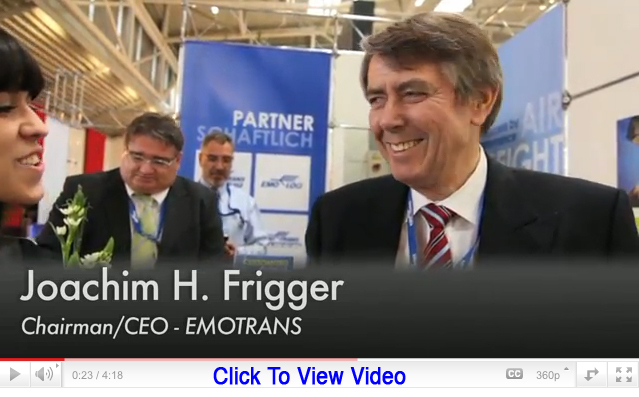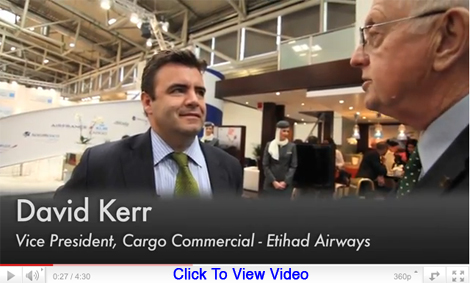
A Widebody Aircraft Becomes
A Legend
November 23, 1971, was definitely a historically
significant day for Lufthansa. As the first and only airline in the
world to date, it had placed an order for a “pure” 747 F
Jumbo wide-body freighter, which finally rolled out of the assembly
hanger of the Boeing works in Seattle, Washington late in autumn.
The total price of this airplane amounted
to 82 million DM and Lufthansa wanted to use this aircraft to fly six
runs a week between New York and Frankfurt. Higher capacities, more
flexibility and economic efficiency were expected because of its 100-ton
freight volume. But, above all, it was expected to give Lufthansa the
edge in order to keep abreast of the increasingly tough competition
in the 1970s.
In addition, this wide-bodied aircraft
was to offer an alternative to sea transport: The new giant of the air
offered freight capacities that were unknown to the air cargo industry.
Up to this time, air transport could not for the most part compete with
sea transport, especially over the North Atlantic; but this revolutionary
aircraft was able to redefine the meaning of competition in this area.
Unfortunately, the acquisition of this Jumbo-aircraft, which was without
question the German carrier’s greatest, pioneering achievement,
posed a great financial risk. Other investments, including handling-
and loading equipment, were needed in order to provide smooth operations
in the future and to do justice to this innovative means of transportation.
The 747F Takes Up Service
On the April 19, 1972, the time had finally
come. The largest load of commercial freight that had ever been carried
in an airplane was flown in the Jumbo from Frankfurt to New York. The
cargo, a manufacturing facility composed of a total of twenty-five electronically
controlled, circular knitting machines, attained the impressive weight
of 83 tons.
The handling of this flight, including
the spectacular onloading with the self-designed and developed loading
equipment, demonstrated clearly the efficiency of Lufthansa and showed
the importance of Germany in the international airfreight industry.
The German airfreight handlers were also capable of mastering the follow-up
overland transports with special vehicles, because the valuable freight
had to be brought from New York to Spartanburg in the State of South
Carolina.
In this way, it became crystal clear
that putting the 747F into operation was not only a challenge for the
carrier and the airports, but also for the handling agents. Every single
link in the handling chain, which was mandated to carry through similar
assignments, had to be ready for the challenges that the new transport
concept brought with it.
Within a short year, Lufthansa was able
to report positively overall about the wide body freighter. In its first
year of operation, 29,691 tons of freight, including airmail, had been
carried from Frankfurt to New York, or New York to Frankfurt.
It is important to note that all flights
had taken place without technical difficulties. The 630-cubic meter
cargo-hold was indeed impressive: It matched the freight capacity of
six 737-freighters. That allowed the length of the largest piece of
freight to be 50 meters, its width to be 3 meters and its height to
be 2.5 meters – and, just for the record, the air freighter itself
was 71 long with a wingspan of 60 meters at least. With a Maximum Takeoff
Weight of 363 tons, the jumbo was a real heavyweight. The tanks of the
Jumbos held 197,000 liters of kerosene, whereas the average fuel consumption
measured 15,500 liters per hour.
Two of the Boeing 747 F’s real
advantages have proven to be the bow loading hatch, jocularly known
as the “nose door,” and the on-board roller system for the
loading/unloading of containers and pallets. Even so, the loading of
this “cargo giant” posed somewhat of a challenge for board-
and ground personnel. Before take-off, precision work was required of
the pilots: the nose of the Jumbo had to be brought into position inch
by inch on the loading apparatus. No gaps were tolerated between the
cabin of the aircraft and the elevating platform. After this maneuver,
the pilots exited the plane’s cockpit via a 20-meter high mobile
staircase and turned the Boeing 747 F -freighter over to the freight
specialists.
The loadmaster first activated the already
mentioned bow loading hatch – this was then the Jumbo looked like
it was starting to smile. Only when the front section of the cabin was
completely open could the loading begin. With the help of some electronic
equipment, (for example, the on-board roller system) the extremely heavy
loads were effortlessly onloaded and stacked in the cargo hold of the
freighter. In order to do this, little levers in the sidewalls of the
cabin had to be activated so that the pieces of freight could be moved
around in the belly of the aircraft completely automatically on rollers
and switch-overs. In little more than an hour, it was possible to completely
offload a jumbo-freighter and then, in the same time, on-load it once
again. Furthermore, Lufthansa utilized
so-called “bungalow-containers,” which had been expressly
developed for use in the Jumbo. These containers were sturdy enough
and at the same time light enough to make the transport in the airplane
even more economical. The main difference between these and any other
containers—like the “Iglus,” which were still in service—was
the rectangular construction, which allowed for the complete utilization
of the entire interior volume of the unit. At the same time, the container
could be used for on-going or follow-up road forwarding operations –
thus ensuring the first genuine “house to house service”
in the history of airfreight.
No one can deny that the German carrier
with the Jumbo-freighter set completely new standards for the industry,
and no one is surprised to learn that very soon other airfreight companies,
like British Airways and Seaboard, introduced a Boeing 747F into their
fleets. The first year of operations was a complete success for Lufthansa,
and consequently the head of the freight division, Siegfried Köhler,
was pleased to sum up: “The technical perfection of the Boeing
747F’s flight operations has proven that we are dealing with a
technically mature aircraft.”
Matthias Appinger - The University of Vienna
Please Note: Germany goes gala over air cargo with
a week long celebration that commences on August 17th and begins with
the unveiling of a new book commissioned by Lufthansa entitled “100
Years of Air Cargo.”
The landing page to keep up with the latest happenings and celebration
of 100 Years of Air Cargo is http://www.100-years-air-cargo.com/
|





